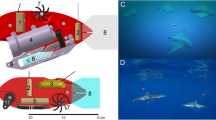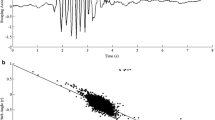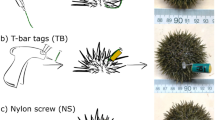Abstract
Biologging technology has provided scientists with unprecedented tools to investigate the ecology and behaviour of marine animals, but tag deployment and attachment methods have lagged behind. Electronic tagging of elasmobranchs still essentially involves implanting anchors or drilling the fins of restrained animals. Here, we present two new non-invasive methods for deploying satellite and biologging tags on pelagic sharks and rays that do not require restraining or manipulation of the animals, nor the attachment of intramuscular anchors. The attachment of a modified fin clamp and a harness systems were tested on 12 blue sharks and four devil rays in the Azores, mid-north Atlantic. Clamps and harnesses were fitted with galvanic timed releases and deployed manually by a free diver or from the boat using a harness tagging pole. The tags remained on the animals over the entire short-term duration of the trials. Focal observations and deployment data suggest that both methods produce little or no adverse behavioural reaction on the animals, offering a valid alternative for short-term tagging of pelagic sharks and rays. Deployment length can be substantially increased by selecting longer duration galvanic timed releases.










Similar content being viewed by others
References
Bograd SJ, Block BA, Costa DP, Godley BJ (2010) Biologging technologies: new tools for conservation. Endanger Species Res 10:1–7
Braun CD, Skomal GB, Thorrold SR, Berumen ML (2014) Diving behavior of the reef manta ray links coral reefs with adjacent deep pelagic habitats. PLoS One 9:e88170. https://doi.org/10.1371/journal.pone.0088170
Brunnschweiler JM, Payne NL, Barnett A (2017) Hand feeding can periodically fuel a major portion of bull shark energy requirements at a provisioning site in Fiji. Anim Conserv. https://doi.org/10.1111/acv.12370
Campana SE, Dorey A, Fowler M, Joyce W, Wang Z, Wright D, Yashayaev I (2011) Migration pathways, behavioural thermoregulation and overwintering grounds of blue sharks in the Northwest Atlantic. PLoS One 6:e16854
Carey F, Scharold J, Kalmijn AJ (1990) Movements of blue sharks (Prionace glauca) in depth and course. Mar Biol 106:329–342
Chapple TK, Gleiss AC, Jewell OJ, Wikelski M, Block BA (2015) Tracking sharks without teeth: a non-invasive rigid tag attachment for large predatory sharks. Animal Biotelemetry 3:1
Danylchuk AJ, Suski CD, Mandelman JW, Murchie KJ, Haak CR, Brooks AM, Cooke SJ (2014) Hooking injury, physiological status and short-term mortality of juvenile lemon sharks (Negaprion brevirostris) following catch-and-release recreational angling. Conserv Physiol 2:cot36
Dicken M (2014) Socio-economic aspects of the Sodwana Bay SCUBA diving industry, with a specific focus on sharks. Afr J Mar Sci 36:39–47
Dicken M, Hosking S (2009) Socio-economic aspects of the tiger shark diving industry within the Aliwal Shoal Marine Protected Area, South Africa. Afr J Mar Sci 31:227–232
Francis MP, Jones EG (2016) Movement, depth distribution and survival of spinetail devilrays (Mobula japanica) tagged and released from purse-seine catches in New Zealand. Aquat Conserv Mar Freshwat Ecosyst. https://doi.org/10.1002/aqc.2641
Gallagher A, Serafy J, Cooke S, Hammerschlag N (2014) Physiological stress response, reflex impairment, and survival of five sympatric shark species following experimental capture and release. Mar Ecol Prog Ser 496:207–218
Gallagher AJ, Vianna GM, Papastamatiou YP, Macdonald C, Guttridge TL, Hammerschlag N (2015) Biological effects, conservation potential, and research priorities of shark diving tourism. Biol Conserv 184:365–379
Gleiss AC, Norman B, Liebsch N, Francis C, Wilson RP (2009) A new prospect for tagging large free-swimming sharks with motion-sensitive data-loggers. Fish Res 97:11–16
Hammerschlag N, Gallagher A, Lazarre D (2011) A review of shark satellite tagging studies. J Exp Mar Biol Ecol 398:1–8
Hays GC, Ferreira LC, Sequeira AM, Meekan MG, Duarte CM, Bailey H, Bailleul F, Bowen WD, Caley MJ, Costa DP (2016) Key questions in marine megafauna movement ecology. Trends Ecol Evol 31:463–475
Hussey NE, Kessel ST, Aarestrup K, Cooke SJ, Cowley PD, Fisk AT, Harcourt RG, Holland KN, Iverson SJ, Kocik JF (2015) Aquatic animal telemetry: a panoramic window into the underwater world. Science 348:1255642
Jaine F, Rohner C, Weeks S, Couturier L, Bennett M, Townsend K, Richardson A (2014) Movements and habitat use of reef manta rays off eastern Australia: offshore excursions, deep diving and eddy affinity revealed by satellite telemetry. Mar Ecol Prog Ser 510:73–86
Jewell OJ, Wcisel MA, Gennari E, Towner AV, Bester MN, Johnson RL, Singh S (2011) Effects of smart position only (SPOT) tag deployment on white sharks Carcharodon carcharias in South Africa. PLoS One 6:e27242
Klimley AP, Beavers SC, Curtis TH, Jorgensen SJ (2002) Movements and swimming behavior of three species of sharks in La Jolla Canyon, California. Environ Biol Fishes 63:117–135
Kohler NE, Turner PA (2001) Shark tagging: a review of conventional methods and studies the behavior and sensory biology of elasmobranch fishes: an anthology in memory of Donald Richard Nelson. Springer, New York, pp 191–224
Queiroz N, Humphries NE, Noble LR, Santos AM, Sims DW (2012) Spatial dynamics and expanded vertical niche of Blue Sharks in oceanographic fronts reveal habitat targets for conservation. PLoS One 7:e32374. https://doi.org/10.1371/journal.pone.0032374
Rohner C, Richardson A, Marshall A, Weeks S, Pierce S (2011) How large is the world’s largest fish? Measuring whale sharks Rhincodon typus with laser photogrammetry. J Fish Biol 78:378–385
Rohner CA, Richardson AJ, Prebble CE, Marshall AD, Bennett MB, Weeks SJ, Cliff G, Wintner SP, Pierce SJ (2015) Laser photogrammetry improves size and demographic estimates for whale sharks. PeerJ 3:e886
Stevens JD, Bradford RW, West GJ (2010) Satellite tagging of blue sharks (Prionace glauca) and other pelagic sharks off eastern Australia: depth behaviour, temperature experience and movements. Mar Biol 157:575–591
Sundström L, Gruber S (2002) Effects of capture and transmitter attachments on the swimming speed of large juvenile lemon sharks in the wild. J Fish Biol 61:834–838
R Core Team (2013) R: a language and environment for statistical computing, Vienna. http://www.R-project.org
Thomson JA, Heithaus MR (2014) Animal-borne video reveals seasonal activity patterns of green sea turtles and the importance of accounting for capture stress in short-term biologging. J Exp Mar Biol Ecol 450:15–20
Thorrold SR, Afonso P, Fontes J, Braun CD, Santos RS, Skomal GB, Berumen ML (2014) Extreme diving behaviour in devil rays links surface waters and the deep ocean. Nat Commun 5:4274
Vianna G, Meekan M, Pannell D, Marsh S, Meeuwig J (2012) Socio-economic value and community benefits from shark-diving tourism in Palau: a sustainable use of reef shark populations. Biol Cons 145:267–277
Whitney NM, White CF, Gleiss AC, Schwieterman GD, Anderson P, Hueter RE, Skomal GB (2016) A novel method for determining post-release mortality, behavior, and recovery period using acceleration data loggers. Fish Res 183:210–221. https://doi.org/10.1016/j.fishres.2016.06.003
Wilson RP (2011) Animal behaviour: the price tag. Nature 469:164–165
Acknowledgements
This study had the support of Fundação para a Ciência e Tecnologia (FCT), through the strategic project UID/MAR/04292/2013 Granted to MARE, the projects EcoDive (ACORES-01-0145-FEDER-000059), BALA (13/DRAM/2015), and AtlantOS (BG-8-2014). JF, RP, and PA were supported by FCT Grants (SFRH/BPD/66532/2009, SFRH/BPD/108007/2015, and FCT/IF/01640/2015, respectively). Authors would also like to acknowledge Simon Thorrold for providing the satellite tags, Pedro Mesquita for the illustrations and the local dive operators for providing assistance with field work: Dive Azores, CW Azores, NorbertoDiver and PicoSport, and their staff. Finally, the authors thank the Waitt foundation and the Oceano Azul foundation for contributing with boat support.
Funding
This study was funded by Açores 2020 EcoDive (ACORES-01-0145-FEDER-000059).
Author information
Authors and Affiliations
Corresponding author
Ethics declarations
Ethical approval
All applicable international, national, and/or institutional guidelines for the care and use of animals were followed.
Conflict of interest
Author A declares that he/she has no conflict of interest.
Additional information
Responsible Editor: J.D.R. Houghton.
Reviewed by A. Gleiss and an undisclosed expert.
Electronic supplementary material
Below is the link to the electronic supplementary material.
Rights and permissions
About this article
Cite this article
Fontes, J., Baeyaert, J., Prieto, R. et al. New non-invasive methods for short-term electronic tagging of pelagic sharks and rays. Mar Biol 165, 34 (2018). https://doi.org/10.1007/s00227-018-3289-z
Received:
Accepted:
Published:
DOI: https://doi.org/10.1007/s00227-018-3289-z




